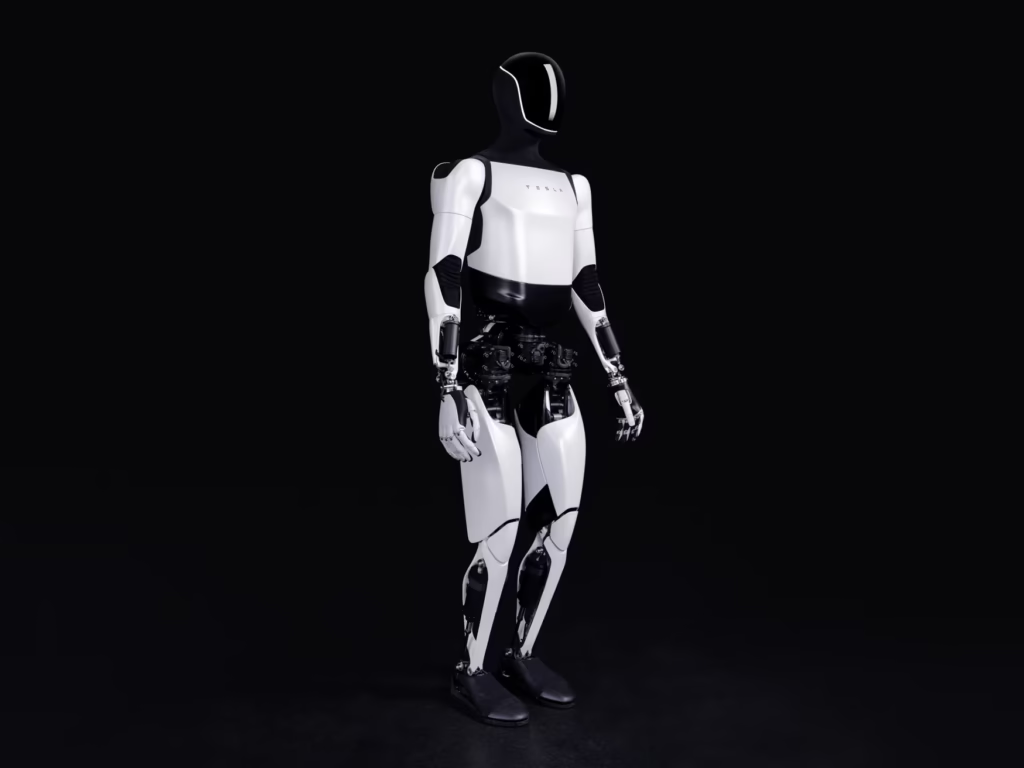Introduction
Tesla’s ambition to revolutionize transportation with autonomous vehicles like the Robotaxi is well-known, but the company’s foray into humanoid robotics with the Optimus robot is equally groundbreaking. Unveiled in 2021, Optimus aims to transform industries by performing repetitive or dangerous tasks, powered by Tesla’s cutting-edge AI. As 2025 approaches, anticipation is building for significant advancements in Optimus’s capabilities. From factory work to potential home applications, what can we expect from Tesla’s Optimus robot in 2025? Let’s dive into the latest updates and predictions.

The Vision Behind Optimus
Tesla’s Optimus, also known as Tesla Bot, is designed to leverage the same AI technology driving its Full Self-Driving (FSD) system. Elon Musk envisions Optimus as a versatile humanoid robot capable of tasks like assembling cars, carrying heavy loads, or even fetching groceries. According to Musk’s posts on X, Optimus could eventually outnumber humans, becoming a ubiquitous helper. The robot stands approximately 5’8” tall, weighs 125 pounds, and is engineered for human-like agility, making it suitable for diverse environments.
Progress in 2024: Setting the Stage
In 2024, Tesla showcased Optimus performing basic tasks like walking, folding clothes, and navigating factory floors, as seen in videos shared on X. These demonstrations highlighted improvements in balance, dexterity, and AI processing, powered by Tesla’s Dojo supercomputer. Web sources like Electrek report that Optimus can now handle simple assembly tasks in Tesla’s Fremont factory, reducing human labor in repetitive roles. However, challenges like battery life and complex task execution remain, setting the stage for 2025 breakthroughs.
What to Expect in 2025
As Tesla accelerates Optimus development, 2025 promises significant milestones. Here’s what industry experts and recent X discussions suggest:
1. Enhanced AI and Autonomy
Tesla’s Optimus will likely integrate advanced neural networks, similar to those used in the Robotaxi program launching in Austin in June 2025. CNBC reports that Tesla plans to upgrade Optimus’s AI to enable semi-autonomous task execution, such as sorting materials or responding to voice commands. This could make Optimus a viable assistant in Tesla’s Gigafactories, boosting production efficiency.
2. Expanded Factory Deployment
Musk has hinted on X that Optimus will see wider deployment in Tesla factories by mid-2025. Teslarati suggests that Optimus could handle up to 20% of repetitive tasks in Shanghai and Berlin Gigafactories, reducing costs and human error. This aligns with Tesla’s goal to scale production of vehicles like the Cybertruck and Model Y.
3. Improved Hardware
Web sources like The Verge indicate that Tesla is developing lighter, more durable actuators for Optimus, improving its lifting capacity to 50 pounds. Enhanced battery life (up to 4 hours) will allow longer operation, critical for industrial use. These upgrades will make Optimus more robust and versatile.
4. Potential Consumer Applications
While primarily aimed at industrial tasks, Musk has teased consumer applications for Optimus, such as household chores. A 2025 prototype may demonstrate tasks like cleaning or delivery, as discussed on Reddit. However, mass consumer availability is likely years away, with 2025 focusing on pilot programs.
Challenges and Public Perception
Despite the excitement, Optimus faces hurdles. Battery efficiency, safety in human-robot interactions, and cost (estimated at $20,000–$30,000) are concerns raised on X. Some users worry about job displacement, while others see Optimus as a solution to labor shortages. Tesla emphasizes safety protocols, drawing from its Robotaxi testing experience, to address these concerns.
Conclusion
Tesla’s Optimus robot is poised to make significant strides in 2025, from enhanced AI and factory deployment to improved hardware and early consumer demos. As Tesla pushes the boundaries of robotics, Optimus could redefine how we work and live. Stay tuned to EnergyFutureAI for the latest updates on Tesla’s transformative journey in AI and robotics.
Sources:
Pingback: Tesla’s Future in 2025 – Pioneering the Next Tech Era - Future Energy Robots AI